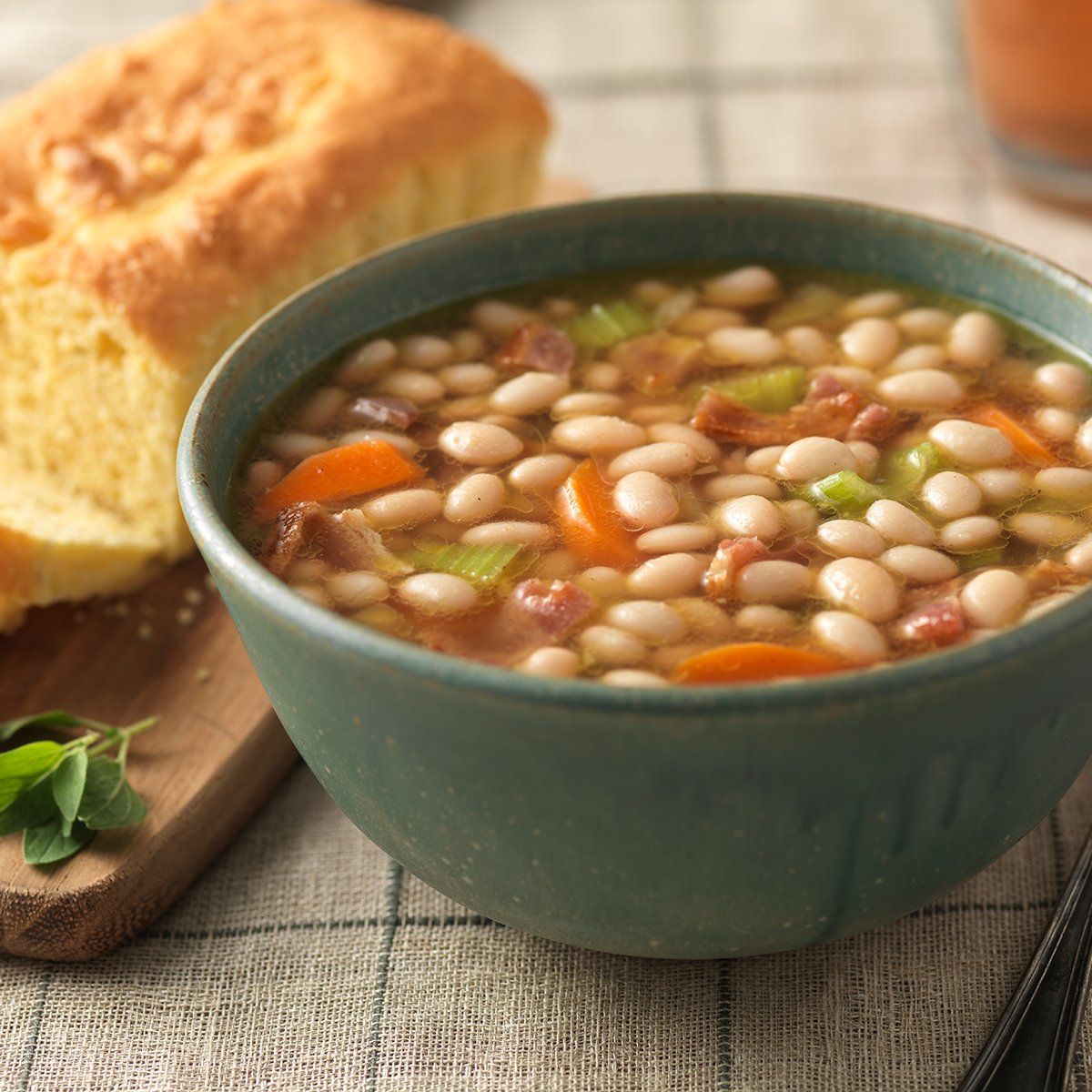Benefits of Navy BeansBy Constance & Dallas Salas
Benefits of Navy Beans
By Constance & Dallas Salas
Nutrition Facts
Nutrition Facts
Nutritional facts
Calories 254.8
Potassium 708 mg
Carbohydrates 47.4g
Net carbs 28.3g
Sugar 0.67g
Fiber 19.1g
Sucrose 0.7g
Vitamin B1 0.43 mg
Vitamin B2 0.12 mg
Vitamin B3 1.18 mg
Vitamin B6 0.3 mg
Vitamin C 1.6 mg
Vitamin K 1.09 mcg
Calcium 125.6 mg
Iron 4.3 mg
Magnesium 96.5 mg
Phosphorus 262.1 mg
Zinc 1.9 mg
Copper 0.4 mg
Manganese 1 mg
Thiamine 0.4 mg
Riboflavin 0.1 mg
Niacin 1.2 mg
Choline 81.4 mg
Betaine 0.2 mg
Water 116.1 g
Omega 3 0.3g
Omega 6 0.25g
Water [g] 79.15
Energy [kcal] 67
Protein [g] 6.15
Total lipid (fat) [g] 0.7
Carbohydrate, by difference [g] 13.05
Calcium, Ca [mg] 15
Iron, Fe [mg] 1.93
Magnesium, Mg [mg] 101
Phosphorus, P [mg] 100
Potassium, K [mg] 307
Sodium, Na [mg] 13
Zinc, Zn [mg] 0.89
Vitamin C, total ascorbic acid [mg] 18.8
Thiamin [mg] 0.39
Riboflavin [mg] 0.22
Niacin [mg] 1.22
Vitamin B-6 [mg] 0.19
Folate, DFE [µg] 132
Vitamin A, IU [IU] 4
Fatty acids, total saturated [g] 0.09
Fatty acids, total monounsaturated [g] 0.05
Fatty acids, total polyunsaturated [g] 0.41
Fatty acids, total trans [g] 0
Cholesterol [mg] 0
Benefits of Navy Beans
The Navy Bean has been a staple in the Nation of Islam diet since the 1930’s. The Nation of Islam founder The Honorable Elijah Muhammad promoted a healthy diet. This diet introduced the Muslim Navy Bean Soup and the Nation of Islam Original Navy Bean Pie. The Navy Bean Pie was implemented as a healthier substitute for Sweet Potato pie.
Navy beans assist with anti-aging because they are loaded with copper. Copper helps the body produce collagen. Collagen gives the skin a smooth, firm, and youthful appearance. Navy beans regulate our bodies metabolism due to the high levels of manganese.
Studies have proven that a folate deficiency can cause an increase of homocysteine levels which can lead to neurodegenerative diseases like Alzheimer's disease and Parkinson's disease. Navy Beans are rich in Thiamin can increase neurotransmitters necessary for maintaining memory.
Navy beans are rich in an antioxidant called polyphenols. Polyphenols is involved in the fight against ultraviolet radiation.
Studies show that when navy beans are consumed above the 5% dietary intake they have demonstrated CRC chemoprotective activity in animal studies and were associated with a reduced recurrence adenomatous polyps.

Slide title
Write your caption hereButton
Ingredients
Ingredients
Basic Cooking Instructions for Navy Bean Soup
Courtesy of The Nation of Islam Ministry of Agriculture
Ingredients
2 cups of navy beans
6 cups of water
Pick over beans and remove any stones or dark discolored beans.
Soak the navy beans overnight in a large bowl. Cover beans with about 2-3 inches of water. The beans will swell so you want to make sure they stay covered with water. Soaking the beans helps to breakdown enzymes and lessen “gas”.
Place the drained beans into a large pot or Dutch oven and cover with 6 cups fresh water for each pound (2 cups) of beans, or to about at least 2-3 inches above the beans. Add 1 to 2 Tablespoons oil (to prevent boiling over).
Boil gently with lid tilted until tender when taste tasted.
And that’s basically it.
A few notes and tips:
Cooking beans can take from 1-2 hours. It all depends on how fresh the beans are. The longer they’ve been sitting on the shelf since they were picked, the longer it takes to cook them and the tougher they are. Really fresh beans do not require a lot of time to cook. They cook quick and are very tender. So keep an eye on very fresh beans you don’t want them to turn into mush. I once cooked beans on high heat, so rough (hard boiling) they disappeared!
Add hot water as needed to keep beans just covered with liquid. The best rule is to test frequently during cooking, then come to your own decision when beans are tender (most recipes will tell you to cook beans until tender. To check for tenderness, pinch or bite a few beans at a minimum suggested time, then every 10 to 15 minutes until the beans are tender).
Always simmer beans gently. Hard prolonged boiling will cause the skins to split and beans to act crazy. Don’t have them jumping violently out of the pot. Be nice to your beans. Pray over them. Give them tender loving care and they will give the tender loving care you and your stomach both need.
Cooking beans on top of the stove is a slow process that allows the flavors of the beans and seasoning to intermingle, creating the hearty flavor you expect from bean dishes.
When dried beans boil, a foam forms on the top of the cooking liquid. This foam is water-soluble protein released from the beans and it will be absorbed back into the bean cooking liquid. It is not necessary to remove the foam. To keep the foam down when cooking beans, add 1 Tablespoon of butter, or olive oil salad oil, for each cup of beans.
The best cookware for beans is a stainless steel pot. Never use aluminum pots and pans. You can also use cast iron. I personally like using cast iron pots (dutch ovens) for making baked beans. Both are excellent. Pressure Cookers should be stainless steel.
by: Lisa Muhammad Atlanta MOA
INGREDIENTS
FOR THE CRUSTS
About 2 1/4 cups (9 1/2 ounces) whole-wheat flour, plus more for the work surface
1/2 teaspoon salt
2 tablespoons corn or vegetable oil, plus more for greasing
3 tablespoons ice-cold water, or more as needed
1 large egg, beaten
FOR THE FILLING
3 cups sugar
16 tablespoons (2 sticks) unsalted butter, at room temperature
2 tablespoons ground cinnamon
2 tablespoons cornstarch
5 large eggs, beaten
3 cups cooked, no-salt-added navy beans (drained and rinsed if using canned)
2 cups evaporated milk
5 drops yellow food coloring (optional)
1 teaspoon lemon extract (may substitute 1 tablespoon fresh lemon juice)
Directions
For the crusts: Combine the flour and salt in a food processor; add the oil and pulse until it is evenly distributed (the flour will darken a bit). With the motor running, gradually add the water and egg; pulse just until a ball of dough forms, adding water by the tablespoon as needed.
Use a little oil to grease the inside of each pie plate. Lightly flour a work surface. Turn the dough out onto it; divide it into two equal portions. Working with one portion at a time, roll out to a round that’s about 11 inches across, then transfer to a pie plate, letting the excess dough hang over the edges. Refrigerate while you make the filling.
For the filling: Combine the sugar and butter in the bowl of a stand mixer or handheld electric mixer. Beat on medium speed for 5 minutes, stopping to scrape down the bowl as needed. Stop to add the cinnamon and cornstarch; beat on low speed just until incorporated. On low speed, gradually add the eggs; once they are all incorporated, stop to scrape down the bowl.
Mash or puree the beans (in a food processor) with 1 cup of the milk in a separate bowl, then add to the mixing bowl; beat on low speed until well incorporated, then add the remaining cup of milk, the food coloring, if using, and the lemon extract, beating until well blended. The filling mixture might look slightly curdled; that is okay.
Preheat the oven to 400 degrees.
Divide the filling evenly between the dough-lined pie plates, smoothing each filling surface. Tuck under and crimp the dough around the edges. Bake (middle rack) for 10 minutes, then reduce the temperature to 325 degrees; bake for about 1 hour or until the filling is just set and the top and edges of the crust are nicely browned. Transfer the pies to wire racks to cool for at least 30 minutes before serving; cool completely before storing.
RECIPE SOURCE
Adapted from “Cooking for the Champ: Muhammad Ali’s Favorite Recipes,” by Lana Shabazz (Jones-McMillon, 1979).
Universal Cellphone & Repair.
Show Us Your Crack...We'll Fix It!
Free Cellphone Case & Screen/Glass Protector With Every Screen Repair
We have Chargers, Screen Protectors, Phone Cases and EarPods
Copyright © 2023, Urban AZ News Journal INC, Powered by Digital SEO INC.










